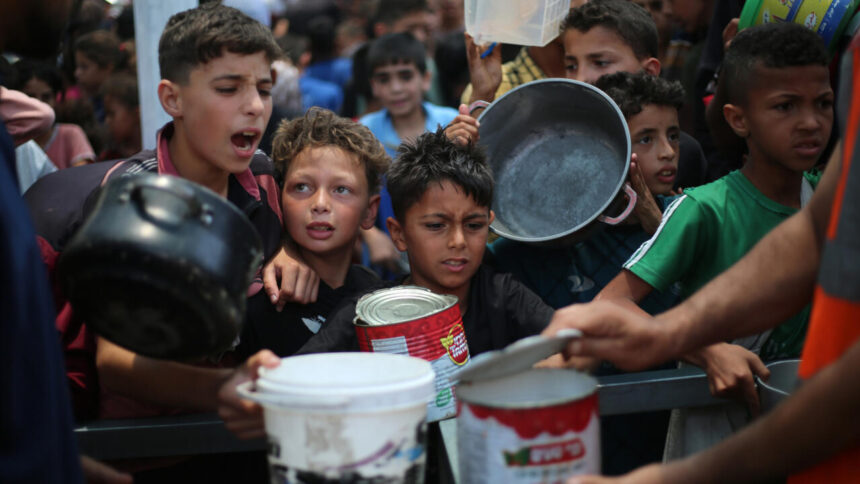Article – I’ve spent the last three days speaking with aid workers along Gaza’s southern border. The stories they share mirror the scathing UN report released yesterday that formally accused Israeli forces of deliberately obstructing humanitarian food access—creating what experts now classify as a manufactured famine affecting over 2.3 million Palestinians.
“We have food sitting in warehouses just kilometers away while children are starving,” explained Mohammed Saleh, a coordinator with the World Food Programme who requested I use only his first name for security reasons. “The blockages aren’t accidental or incidental. They’re systematic.”
The UN’s detailed 87-page assessment concludes that Israeli authorities have employed food deprivation as a “method of warfare” in Gaza—language that carries significant legal implications under international humanitarian law. The report catalogs hundreds of incidents where aid convoys were denied entry despite prior coordination, humanitarian workers detained, and distribution centers targeted.
Israel’s foreign ministry spokesperson Lior Haiat immediately rejected the findings, calling them “a dangerous distortion of reality” and insisting that Hamas bears responsibility for the deteriorating conditions. Yet satellite imagery and documentation from multiple UN agencies show a dramatic reduction in food trucks entering Gaza—from approximately 500 daily before October to fewer than 60 on most days since January.
The humanitarian consequences are devastating. At Al-Aqsa Hospital in central Gaza yesterday, I observed children with the telltale signs of severe malnutrition: distended bellies, thinning hair, and listless expressions. Dr. Nasser Ibrahim showed me records indicating a 400% increase in malnutrition cases since December.
“We’re treating conditions I’ve only read about in textbooks,” Ibrahim told me as we walked through overcrowded hospital corridors. “When mothers cannot produce breast milk because they themselves are starving, the youngest infants have no chance.”
According to data from UNICEF and the World Health Organization, at least 27 Palestinians—mostly children—have died directly from malnutrition and dehydration. Medical professionals believe the actual number is substantially higher, as many deaths go undocumented in areas cut off from functioning healthcare.
The report specifically criticizes Israel’s “buffer zone” policy that has rendered approximately 40% of Gaza’s arable farmland inaccessible, further intensifying food insecurity. Fishermen report being unable to access coastal waters, eliminating another traditional food source.
I spoke with Fatima Abed, a mother of four sheltering in Rafah, who described preparing “soup” from grass and weeds collected from between tent rows. “We boil anything green we can find,” she said, showing me a pot of murky liquid. “Sometimes we add salt if we have it. My children cry from hunger, but there is nothing else.”
The evidence of deliberate obstruction has become impossible to ignore. Last month, I witnessed Israeli forces turn back a convoy of 18 trucks carrying flour and cooking oil despite having received prior coordination. The trucks sat idle for three days before being ordered to return to Egypt.
“The coordination mechanism has broken down completely,” explained a senior UN official who requested anonymity due to ongoing negotiations. “We receive approvals on paper, but when convoys arrive at crossings, the reality on the ground is entirely different.”
The report also documents what it calls a “pattern of targeting” food infrastructure. Since October, satellite imagery confirms that 70% of Gaza’s bakeries have been destroyed or damaged beyond operation. Agricultural facilities, including greenhouses and irrigation systems, have been bulldozed in what appears to be a systematic manner.
This assessment comes as international pressure mounts on Israel to address the humanitarian crisis. Last week, seventeen countries, including France and Spain, issued a joint statement calling for “immediate and unrestricted humanitarian access” to Gaza.
The legal implications of weaponizing food are severe. The Rome Statute of the International Criminal Court specifically classifies “deliberately causing great suffering, or serious injury to body or health” and “intentionally using starvation of civilians as a method of warfare” as war crimes.
When I asked Saleh from WFP what would make the most immediate difference, his answer was simple: “Open the crossings. Allow consistent, predictable humanitarian access. We know how to distribute food efficiently, but we cannot distribute what we cannot bring in.”
As Gaza enters its ninth month of conflict, the long-term consequences of food deprivation extend beyond immediate hunger. Medical experts warn of generational impacts from developmental delays and cognitive impairment in children who survive prolonged malnutrition.
Meanwhile, Israel’s supporters in Washington have begun expressing concerns. Three senior U.S. officials recently visited the Kerem Shalom crossing, calling afterward for “dramatically increased” humanitarian access. Yet despite these statements, little has changed on the ground.
As I left Gaza yesterday, I watched mothers sifting through debris for anything edible. The UN report may use diplomatic language in calling this a “man-made food crisis,” but the reality I’ve witnessed is more direct: deliberate starvation employed as a weapon of war.






